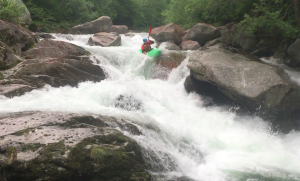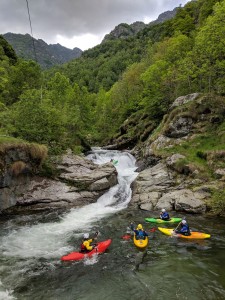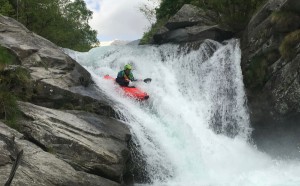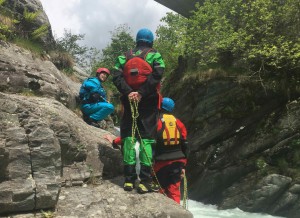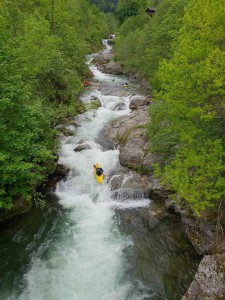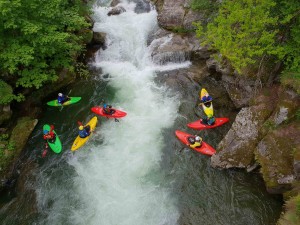My mate Dean booked flights to Milan six months in advance, giving me plenty of time to commit to a long May weekend paddling Val Sesia. Many things can knock a trip like this off the rails – a family emergency, an important piece of work I can’t say no to, injury or illness – but the date stayed clear. In the weeks before we also heard reports of a solid snow pack, meaning that levels would be good too. I found my sense of anticipation growing, along with less familiar worries. What if the rivers are really high? What if we get into trouble? Will I still be able to hack it? Not a keep you awake at night nervousness, more a low-level background hum of minor anxiety.
I was curious about these worries. One the one hand there were plenty of reasons to feel confident: I’ve made four trips to Val Sesia over the last seven years. I’m in good shape and paddle several times a week, albeit mainly on an artificial course in Lee Valley. I would be paddling with people I knew and trusted. I’m paddling a new boat, a Zet Toro that I really love. Yet I was still a little anxious. I decided the most productive response was to commit to paddling wisely and to err on the side of caution.
After Thursday evening flights from London, Dean and I squashed into a hire car for the drive to Pila. Airbnb has transformed trips like this, opening up accommodation options we never had access to in the past. John and his boys Luke and Sam had travelled earlier that day, and seemed strangely unenthusiastic when we arrived and woke them up at 1 am.
On Friday morning we met Myles and Ruari and decided to ease into paddling with the sprint section of the Sesia. Sunshine and a decent level meant a very entertaining trip with just enough challenges to blow away any cobwebs. None of us fancied taking on Mollia falls, and instead we headed down the valley to the Gronda. This is a Val Sesia classic; short, steep and runnable at even low levels. Today it wasn’t low, and it wasn’t high – just about the ideal level. As this was Dean’s second Val Sesia trip for the season he knew all the lines, and we started our descent without scouting. Steep, often blind drops right from the start created plenty of opportunity for adventures and led to some unconventional lines and a little damage amongst the group. Thankfully nothing serious enough to bail out, and we eventually found ourselves at Rassa for the spectacular flying squirrel falls, and the final few hundred metres down to the Sorba slides. It was so good we decided to do it all again. After this there was nothing left to do but head back to Campertongo for beers at the campsite.
Another sunny day on Saturday. We rescued Paula from childcare duties for the day, and headed off to the Egua which was running at a premium level. I’ve paddled the Egua maybe half a dozen times, while Paula claims 30 + runs, so I was happy enough to follow her lines. Which were very good! It’s a superb river, non-stop action from a spectacular starting rapid right through to the frankly brilliant last 600 metres of steep whitewater. The last rapid is cylinder falls, a 5 metre fall with a ferocious tow-back that requires ‘livebait’ safety, as there’s no way of swimming out unaided. The group was 50/50 to paddle or finish above the fall, so we set safety for those of us who wanted to paddle. All of which went well until John’s line went awry and he landed at a slight angle and looped back into the fall. The rescue team had rehearsed what to do and an early leap was advised. So, at the first sign of a problem Sam dived in to grab him. The next few moments got quite exciting. John and his boat completely disappeared underwater into the aerated boil, Sam dived and grabbed, a flash of red, a glimpse of yellow helmet. Sudden realisation that the line had looped around Sam’s neck as he was underwater – what to do – pull him up and choke him or let it go loose and he submerges into the river? Showing great presence of mind, Sam freed the line from his neck and grabbed his dad. Pull hard, and they’re both slowly dragged free. No sooner was John safe than Sam dived back for the boat, barely visible as it’s bouncing around underwater at the base of the fall. More yelling, more pulling, until Sam and boat emerge and are pulled to the side. It’s all over in a minute or two but it feels much longer. This was the first time I’d seen this rapid go wrong, and it was sobering to realise the risk not just to the paddler but also to the rescuer.
A little chastened, we refuelled with lunch, coffee and ice-cream before heading down the valley to tackle the lower Sermenzina. I’d paddled the upper section on a previous trip, but this section was new for me. After a couple of rapids, we reached Trumpet Falls, a decent 6 metre fall running through a short pool into another 2-metre drop into an overhanging eddy. Remembering my decision to paddle wisely and err on the side of caution, I decided to portage. Sam and Luke, full of teenage energy and with seemingly bomb-proof rolls, decided to run it. After a bit of scrabbling we set safety for both drops, and the lads proceeded to run the first fall, flip and roll up on landing then survive the final boof. At this point John ran the second drop but ended up pinned against the overhang, and Dean fired off a throwbag with missile-like accuracy. John’s situation wasn’t critical, just inconvenient, and we spent the next few minutes working out a rescue. For a short trip this was turning into a bit of a mission, especially as a landslip a few hundred meters downstream meant another portage and scramble. The last bit of excitement came when I found myself running a fairly serious drop blind, down a line I later discovered wasn’t ideal. I jumped out to wave the others down the right line, feeling a bit stupid for missing the last eddy and not scouting. Paula had wisely decided not to paddle in the afternoon, and by the time we reached the get-out she’d had time to shuttle all 3 cars for us. Winner.
The Egua beckoned again on Sunday, with a slightly higher water level. Compared to the day before, a relatively uneventful trip, although I think each of us was looking to improve lines here and there. Dean was especially pleased to nail the corner rapid just before the finish – he claimed his best line ever. There was no discussion about Cylinder Falls, we all simply got out above it. After a bit of discussion, we settled on the lower section of the Sermenza for our afternoon run. It was running at a decent level, higher than I’d paddled it before, and the lead-in rapid to the gorge was rowdy. The gorge itself comprises a series of bedrock drops and slides, a truly beautiful section of river with crystal clear water and spectacular eroded cliffs. In high spirits we retired to Campertongo for a meal to celebrate Sam and Luke’s nineteenth birthday. I’ll leave the rest of the evening to your imagination.
A magnificent thunder storm kicked off about midnight, and it bucketed with rain all night. We figured this would mean most of the steeper runs would be too high, and we were right. After taking a look at the Gronda, which was basically a 1200 metre non-stop Grade 5+ rapid, we headed down the valley to run a section of the Sesia. Normally a sedate grade 2 cruise, today there were long sections of BIG waves and holes. It was a blast, so different from our previous three days of paddling to be on a big volume river.
And that was it – four days of paddling some of Val Sesia’s best runs was over. The trip had all the right ingredients; a solid paddling crew, bedrock, the right amount of clear water, sunshine, blue sky, great food and beer. A few moments of drama along the way, but fortunately no serious damage. I felt vindicated by my paddling strategy for the trip, pleased to feel strong on the water and paddling within my comfort level. Classic Val Sesia!

